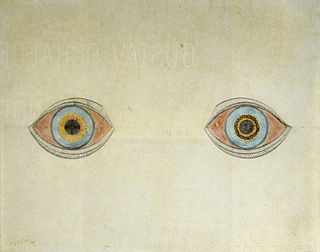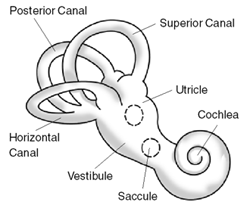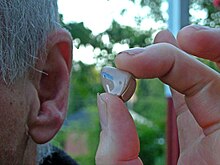
Ramsay Hunt syndrome type 2, commonly referred to simply as Ramsay Hunt syndrome (RHS) and also known as herpes zoster oticus, is inflammation of the geniculate ganglion of the facial nerve as a late consequence of varicella zoster virus (VZV). In regard to the frequency, less than 1% of varicella zoster infections involve the facial nerve and result in RHS. It is traditionally defined as a triad of ipsilateral facial paralysis, otalgia, and vesicles close to the ear and auditory canal. Due to its proximity to the vestibulocochlear nerve, the virus can spread and cause hearing loss, tinnitus, and vertigo. It is common for diagnoses to be overlooked or delayed, which can raise the likelihood of long-term consequences. It is more complicated than Bell's palsy. Therapy aims to shorten its overall length, while also providing pain relief and averting any consequences.

A hallucination is a perception in the absence of an external stimulus that has the qualities of a real perception. Hallucinations are vivid, substantial, and are perceived to be located in external objective space. Hallucination is a combination of two conscious states of brain wakefulness and REM sleep. They are distinguishable from several related phenomena, such as dreaming, which does not involve wakefulness; pseudohallucination, which does not mimic real perception, and is accurately perceived as unreal; illusion, which involves distorted or misinterpreted real perception; and mental imagery, which does not mimic real perception, and is under voluntary control. Hallucinations also differ from "delusional perceptions", in which a correctly sensed and interpreted stimulus is given some additional significance.

Hearing loss is a partial or total inability to hear. Hearing loss may be present at birth or acquired at any time afterwards. Hearing loss may occur in one or both ears. In children, hearing problems can affect the ability to acquire spoken language, and in adults it can create difficulties with social interaction and at work. Hearing loss can be temporary or permanent. Hearing loss related to age usually affects both ears and is due to cochlear hair cell loss. In some people, particularly older people, hearing loss can result in loneliness.

Ménière's disease (MD) is a disease of the inner ear that is characterized by potentially severe and incapacitating episodes of vertigo, tinnitus, hearing loss, and a feeling of fullness in the ear. Typically, only one ear is affected initially, but over time, both ears may become involved. Episodes generally last from 20 minutes to a few hours. The time between episodes varies. The hearing loss and ringing in the ears can become constant over time.
Tinnitus is a variety of sound that is heard when no corresponding external sound is present. Nearly everyone experiences faint "normal tinnitus" in a completely quiet room; but it is of concern only if it is bothersome, interferes with normal hearing, or is associated with other problems. The word tinnitus comes from the Latin tinnire, "to ring". In some people, it interferes with concentration, and can be associated with anxiety and depression.

The temporal lobe is one of the four major lobes of the cerebral cortex in the brain of mammals. The temporal lobe is located beneath the lateral fissure on both cerebral hemispheres of the mammalian brain.
Exploding head syndrome (EHS) is an abnormal sensory perception during sleep in which a person experiences auditory hallucinations that are loud and of short duration when falling asleep or waking up. The noise may be frightening, typically occurs only occasionally, and is not a serious health concern. People may also experience a flash of light. Pain is typically absent.
Visual release hallucinations, also known as Charles Bonnet syndrome or CBS, are a type of psychophysical visual disturbance in which a person with partial or severe blindness experiences visual hallucinations.

Visual snow syndrome (VSS) is a form of visual hallucination that is characterized by the perception of small, flickering dots throughout the visual field. It is present in all conditions of illumination. The dots remain individual and do not clump together or change in size. Visual snow exists in two forms: the pulse type and the broadband type.
Hyperacusis is an increased sensitivity to sound and a low tolerance for environmental noise. Definitions of hyperacusis can vary significantly, but it is often categorized into four subtypes: loudness, pain, annoyance, and fear. It can be a highly debilitating hearing disorder.
Tinnitus retraining therapy (TRT) is a form of habituation therapy designed to help people who experience tinnitus—a ringing, buzzing, hissing, or other sound heard when no external sound source is present. Two key components of TRT directly follow from the neurophysiological model of tinnitus: Directive counseling aims to help the sufferer reclassify tinnitus to a category of neutral signals, and sound therapy weakens tinnitus-related neuronal activity.
Cogan syndrome is a rare disorder characterized by recurrent inflammation of the front of the eye and often fever, fatigue, and weight loss, episodes of vertigo (dizziness), tinnitus and hearing loss. It can lead to deafness or blindness if untreated. The classic form of the disease was first described by D. G. Cogan in 1945.
An auditory hallucination, or paracusia, is a form of hallucination that involves perceiving sounds without auditory stimulus. While experiencing an auditory hallucination, the affected person hears a sound or sounds that did not come from the natural environment.
Geniculate ganglionitis or geniculate neuralgia (GN), also called nervus intermedius neuralgia, Ramsay Hunt syndrome, or Hunt's neuralgia, is a rare disorder characterized by severe paroxysmal neuralgic pain deep in the ear, that may spread to the ear canal, outer ear, mastoid or eye regions. GN may also occur in combination with trigeminal or glossopharyngeal neuralgia.

Cortical deafness is a rare form of sensorineural hearing loss caused by damage to the primary auditory cortex. Cortical deafness is an auditory disorder where the patient is unable to hear sounds but has no apparent damage to the structures of the ear. It has been argued to be as the combination of auditory verbal agnosia and auditory agnosia. Patients with cortical deafness cannot hear any sounds, that is, they are not aware of sounds including non-speech, voices, and speech sounds. Although patients appear and feel completely deaf, they can still exhibit some reflex responses such as turning their head towards a loud sound.
The semicircular canal dehiscence (SCD) is a category of rare neurotological diseases/disorders affecting the inner ears, which gathers the superior SCD, lateral SCD and posterior SCD. These SCDs induce SCD syndromes (SCDSs), which define specific sets of hearing and balance symptoms. This entry mainly deals with the superior SCDS.

Mohr–Tranebjærg syndrome (MTS) is a rare X-linked recessive syndrome also known as deafness–dystonia syndrome and caused by mutation in the TIMM8A gene. It is characterized by clinical manifestations commencing with early childhood onset hearing loss, followed by adolescent onset progressive or , visual impairment from early adulthood onwards and dementia from the 4th decade onwards. The severity of the symptoms may vary, but they progress usually to severe deafness and dystonia and sometimes are accompanied by cortical deterioration of vision and mental deterioration.
Musical hallucinations describes a neurological disorder in which the patient will hallucinate songs, tunes, instruments and melodies. The source of these hallucinations are derived from underlying psychotic illness or hearing impairment. These hallucinations are often rare and are followed by mental decline. A majority of patients who have symptoms of musical hallucinations are older and have onset conditions predisposing them to the disease. While there is no set form of treatment, research has discovered medications and alternative therapies to be successful in alleviating the hallucinations.
Causes of hearing loss include ageing, genetics, perinatal problems, loud sounds, and diseases. For some kinds of hearing loss the cause may be classified as of unknown cause.
Cochlear hydrops is a condition of the inner ear involving a pathological increase of fluid affecting the cochlea. This results in swelling that can lead to hearing loss or changes in hearing perception. It is a form of endolymphatic hydrops and related to Ménière's disease. Cochlear hydrops refers to a case of inner-ear hydrops that only involves auditory symptoms and does not cause vestibular issues.








